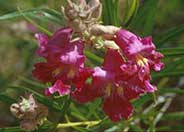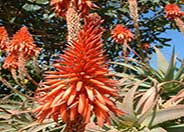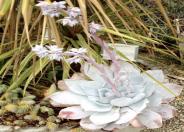
Common name:Mexican Palo Verde, Jerusalem Thorn
Botanical name:Parkinsonia aculeata
Prickly stems. Very fast growing with sparse foliage & very long narrow leaves. Yellow flowers with orange red throats spring for month+. Very messy, thorny, weedy & shortlived. Usually found on limestone soils in areas with moisture but is strongly drought tolerant. Withstands saline conditions. Can be cold or drought deciduous. Half hardy to Dallas. Light airy tree. Green bark.

Common name:Desert Willow
Botanical name:Chilopsis linearis
This desert willow is open and airy as a small tree, and with age develops shaggy bark and twisting trunks. The fragrant flowers of the tree appear in spring or summer while the leaves will drop early. Large brown capsules appear in fall which are attractive to wildlife. Pruning this 25' tree can make it very attractive. Needs good drainage with loam or sandy soil in full sun. Is rather unattractive in winter. Native in desert washes to 5000'. Some supplemental water will improve appearance. Moderately fast growth. Seed pods are persistant. Cannot tolerate overwatering. Flowers on new wood. Hummingbirds are attracted to the flowers. Bark is light green or light gray, exfoliating. Dry fruit produces some litter.

Common name:Tree Aloe
Botanical name:Aloe arborescens
This shrub is large, full of branches, and produces deep orange blooms. The flowers produce a nectar that is attractive to many different birds and the plant is grown all over the world.

Common name:Echeveria cante
Botanical name:Echeveria cante
Among the echeverias which flower in the summer is a beautiful species named Echeveria cante, from the central Mexican state of Zacatecas. When this plant first found its way into cultivation, it was thought to be a form of Echeveria subrigida, which occurs a considerable distance away to the south and the southeast. Both of these have large leaves with a coating of powdery white, but he leaves are shaped differently and the flowers are distinctly different. Still, it was not until 1997 that Echeveria cante was finally described as a species. Echeveria cante can grow to be quite large as echeverias go, with rosettes over a foot across. The powdery whiteness of the leaves is complemented by a reddening at the margins, and the whole rosette can be tinted lavender under some growing conditions. Plants occasionally make a few offsets, but usually they are single. The flower stalks emerge in summer, with flowering commencing in July at the Ruth Bancroft Garden. A plant normally has one or two inflorescences, rising to a height of 1½ to 2 feet, with multiple short side branches bearing several flowers each. The whole stalk and its bract leaves, and even the pink outsides of the flowers, look as though they had been whitewashed. This makes the red to orange color of the flower’s interior stand out. It tolerates full sun in coastal areas but will need shade in inland areas. Does best with well draining soil.
Designer: Ruth Bancroft Garden
Photographer: Vicki Anderson
Practice grass-cycling by leaving short grass clippings on lawns after mowing, so that nutrients and organic matter are returned to the soil.
Remove irrigation water and fertilizer from areas where you don't want weeds to grow.